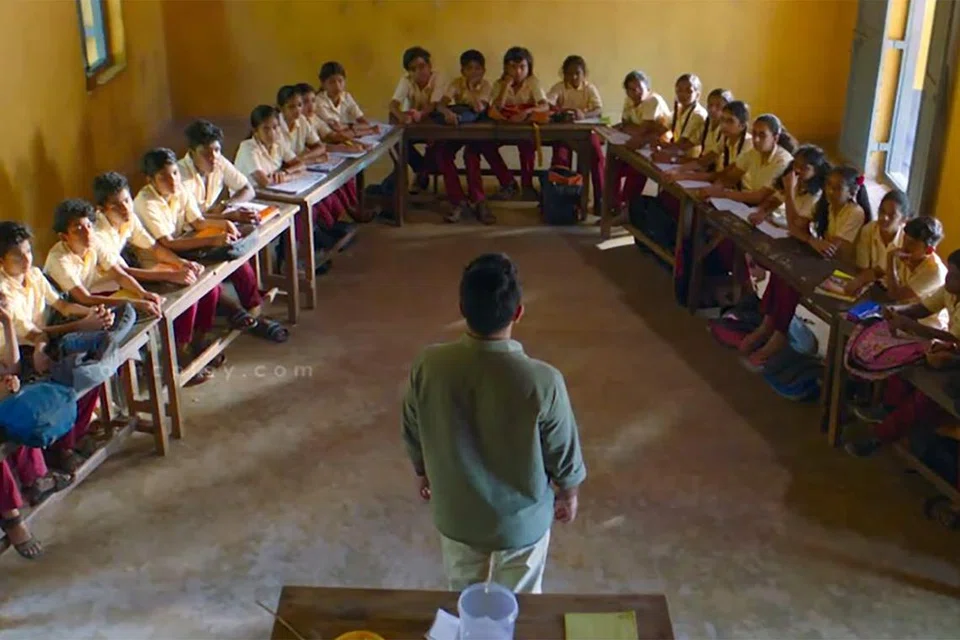A small scene in a Malayalam children’s film has sparked a significant shift in classroom dynamics across Kerala and other Indian states.
The film, Sthanarthi Sreekuttan, directed by Vinesh Viswanath, featured a 7th-grade student proposing a novel classroom seating idea to end the stigma faced by backbenchers.
That fleeting scene has now inspired real-world implementation in several schools, prompting a broader rethink on how seating arrangements can promote inclusivity and better student-teacher engagement, reported India Today.
At the forefront of this movement is Ramavilasom Vocational Higher Secondary School (RVHSS) in Valakom, Kerala.
The school, already proud of its alumna G.P. Nandana, who ranked second in Kerala and 47th nationwide in the Civil Services Examination, is now winning accolades for pioneering a U-shaped classroom layout that ensures no student is left in the metaphorical “back bench”.
“Ganesh Kumar, our school patron and Kerala’s transport minister, saw a preview of the movie and immediately discussed introducing the model,” said Headmaster Sunil P. Sekhar. “We began with one class, saw encouraging results, and have now extended it to all lower primary classes.”
The seating style aligns benches along the four walls of the classroom, allowing every child to sit facing the teacher, and importantly, each other.
The approach has been lauded by educators like Ms Meera, a teacher with 29 years of experience, who says it allows for closer observation and interaction with students. “The students feel included, and the energy in the classroom has become more collaborative,” she noted.
Since the introduction at RVHSS, at least seven other schools in Kerala and one in Punjab have adopted the U-shaped seating, with more expressing interest.
Vinesh shared his amazement at the impact. “It was just one scene, born from my own school memories. I never imagined it would spark such a national conversation,” he said.
The scene’s emotional resonance stems from its authenticity. Vinesh recalled how, under the District Primary Education Programme, his classroom had once adopted a similar layout. Though it faded away due to space constraints, the concept lingered with him and made its way into his film.
Released in November 2024, Sthanarthi Sreekuttan initially received positive reviews but was soon overshadowed at the box office by Pushpa 2: The Rule.
However, the film found new life on the OTT platform Saina. After reports surfaced about its educational influence, viewership surged dramatically.
The seating revolution has even caught the attention of industrialist Anand Mahindra, who welcomed the move in a tweet, despite joking that he personally enjoyed being a backbencher.
In Tamil Nadu, the government is reportedly considering a statewide directive to encourage this model in primary schools.
Critics have raised logistical concerns, particularly in overcrowded classrooms. Vinesh addressed these on social media: “Some said it wouldn’t work with 80 students in a class. But that number violates classroom norms in the first place.”
Schools in Kerala like RCC LPS East Mangad in Thrissur and GHSS Tholanur in Palakkad, have managed to adapt the U-shaped system successfully due to smaller student populations.
Teacher Albert Christin noted: “With just 20 students, the change was easy and effective. It brought a new energy into the room.”
The innovation mirrors teaching methods already common in countries like Finland and Norway, known for their progressive education systems. The emphasis is on breaking hierarchies in the classroom and fostering equality and interaction.
Vinesh, only 31 and a veteran of six short films, was inspired by socially impactful movies like Ustad Hotel, Traffic, and the Tamil film Kaaka Muttai. While his next film will belong to a different genre, he says he is deeply fulfilled that his debut feature has had such a strong social impact.
The film’s success underscores the potential of cinema as a tool for social change. At a time when the influence of films on young minds is under scrutiny, Sthanarthi Sreekuttan stands out as an example of storytelling driving real-world reform.
“Cinema can make a difference,” said Vinesh. “The U-shape seating wasn’t our invention, but if our film helped revive it, that’s a reward greater than box office numbers.”

